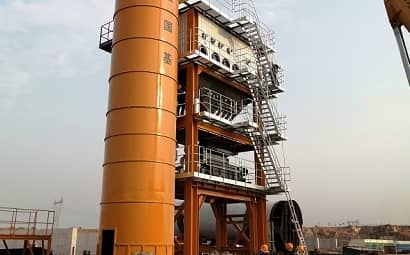Three minutes to distinguish the permeable layer, adhesive layer, and sealing layer and the construction sequence
Don't know what is "permeable layer, adhesive layer, and sealing layer? Or don't know the "permeable layer, adhesive layer, and sealing layer construction sequence" please look over here and read this article carefully!
Let's talk about the construction sequence first. The permeable layer oil must be sprayed within 6 hours after the base layer is rolled. The permeable layer oil uses emulsified asphalt PC-2. The amount can be determined by trial spraying at 1.5 liters per square meter, and the penetration depth is not less than 5mm. After spraying the permeable layer oil, the emulsified asphalt PC-1 lower sealing layer is paved. The amount of emulsified asphalt is 1.0 liters per square meter, the aggregate particle size is 0.5 to 1cm, and the thickness should not be less than 0.6 cm. Before paving asphalt concrete, the adhesive layer oil must be sprayed on the upper and lower layers of the lower sealing layer and on the sides of curbs, rainwater outlets, inspection wells and other structures. The adhesive layer oil is Use emulsified asphalt PC-3, with a dosage of 0.5 liters per square meter.
Permeable layer
The function of the permeable layer is to make the asphalt surface layer and the non-asphalt base layer bond well. It is a thin layer that penetrates the surface of the base layer by pouring emulsified asphalt, coal tar or liquid asphalt on the base layer.
The situations where permeable asphalt should be poured are as follows:
(1) Graded gravel and graded crushed stone base of asphalt pavement;
(2) Cement, lime, fly ash and other inorganic binders stabilized soil;
(3) Permeable asphalt must be poured on the semi-rigid base of granular material.
Adhesive layer
The function of the adhesive layer is to make the upper and lower asphalt structural layers or the asphalt structural layer and the structure (or cement concrete pavement) completely bonded into a whole.
The situations where adhesive layer asphalt should be poured are as follows:
(1) Double-layer or three-layer hot-mix hot-paved asphalt mixture pavement before paving the upper layer , the asphalt layer below it has been contaminated.
(2) Adding an asphalt layer on the old asphalt pavement layer. Or before paving the bridge deck.
(3) Paving the asphalt surface layer on the cement concrete pavement,
(4) The sides of the curbstones, rainwater inlets, inspection wells, etc. that are in contact with the newly laid asphalt mixture.
The role of the seal layer:
(1) Sealing a certain layer to play a role in water retention and waterproofing;
(2) Serving as a transition and effective connection between the base layer and the asphalt surface layer;
(3) Reinforcement of the loose parts of a certain layer of the road surface that is damaged and separated;
(4) Before paving the asphalt surface layer, the base layer must be temporarily opened to traffic to prevent the base layer from being damaged by water due to weather or vehicles.
The seal layer can be divided into an upper seal layer and a lower seal layer; in terms of construction type, a single-layer surface treatment method of mixing or layer paving can be used, or emulsified asphalt can be used. Green slurry seal.
In rainy and humid areas, the asphalt surface layer of expressways and first-class highways has a large porosity and is likely to seep water seriously. Or when the asphalt surface layer cannot be laid in time during the construction of the base layer and vehicles need to pass through, it is advisable to lay the lower seal layer after spraying the oil-permeable layer.
The lower seal layer is set on the surface of the semi-rigid base layer to protect the base layer from being damaged by construction vehicles, facilitate the curing of semi-rigid materials, prevent rainwater from seeping into the structural layer below the base layer, and strengthen the connection between the surface layer and the base layer. There are many construction methods for the lower seal layer.
The upper seal layer should be laid on the asphalt surface layer in the following situations:
(1) The asphalt surface layer has large porosity and severe water seepage.
(2) Old asphalt pavement with cracks or repairs.
(3) Old asphalt pavement that needs to be paved with a wear layer to improve the anti-skid performance.
(4) New asphalt pavement that needs to be paved with a wear layer or protective layer.
What did you learn after reading this article? If you have any questions or suggestions, please leave a message! I will reply to you when I see the message!
 Albanian
Albanian  Russian
Russian  Arabic
Arabic  Amharic
Amharic  Azerbaijani
Azerbaijani  Irish
Irish  Estonian
Estonian  Odia (Oriya)
Odia (Oriya)  Basque
Basque  Belarusian
Belarusian  Bulgarian
Bulgarian  Icelandic
Icelandic  Polish
Polish  Bosnian
Bosnian  Persian
Persian  Afrikaans
Afrikaans  Tatar
Tatar  Danish
Danish  German
German  French
French  Filipino
Filipino  Finnish
Finnish  Frisian
Frisian  Khmer
Khmer  Georgian
Georgian  Gujarati
Gujarati  Kazakh
Kazakh  Haitian Creole
Haitian Creole  Korean
Korean  Hausa
Hausa  Dutch
Dutch  Kyrgyz
Kyrgyz  Galician
Galician  Catalan
Catalan  Czech
Czech  Kannada
Kannada  Corsican
Corsican  Croatian
Croatian  Kurdish (Kurmanji)
Kurdish (Kurmanji)  Latin
Latin  Latvian
Latvian  Lao
Lao  Lithuanian
Lithuanian  Luxembourgish
Luxembourgish  Kinyarwanda
Kinyarwanda  Romanian
Romanian  Malagasy
Malagasy  Maltese
Maltese  Marathi
Marathi  Malayalam
Malayalam  Malay
Malay  Macedonian
Macedonian  Maori
Maori  Mongolian
Mongolian  Bengali
Bengali  Myanmar (Burmese)
Myanmar (Burmese)  Hmong
Hmong  Xhosa
Xhosa  Zulu
Zulu  Nepali
Nepali  Norwegian
Norwegian  Punjabi
Punjabi  Portuguese
Portuguese  Pashto
Pashto  Chichewa
Chichewa  Japanese
Japanese  Swedish
Swedish  Samoan
Samoan  Serbian
Serbian  Sesotho
Sesotho  Sinhala
Sinhala  Esperanto
Esperanto  Slovak
Slovak  Slovenian
Slovenian  Swahili
Swahili  Scots Gaelic
Scots Gaelic  Cebuano
Cebuano  Somali
Somali  Tajik
Tajik  Telugu
Telugu  Tamil
Tamil  Thai
Thai  Turkish
Turkish  Turkmen
Turkmen  Welsh
Welsh  Uyghur
Uyghur  Urdu
Urdu  Ukrainian
Ukrainian  Uzbek
Uzbek  Spanish
Spanish  Hebrew
Hebrew  Greek
Greek  Hawaiian
Hawaiian  Sindhi
Sindhi  Hungarian
Hungarian  Shona
Shona  Armenian
Armenian  Igbo
Igbo  Italian
Italian  Yiddish
Yiddish  Hindi
Hindi  Sundanese
Sundanese  Indonesian
Indonesian  Javanese
Javanese  Yoruba
Yoruba  Vietnamese
Vietnamese  Hebrew
Hebrew  Chinese (Simplified)
Chinese (Simplified)





